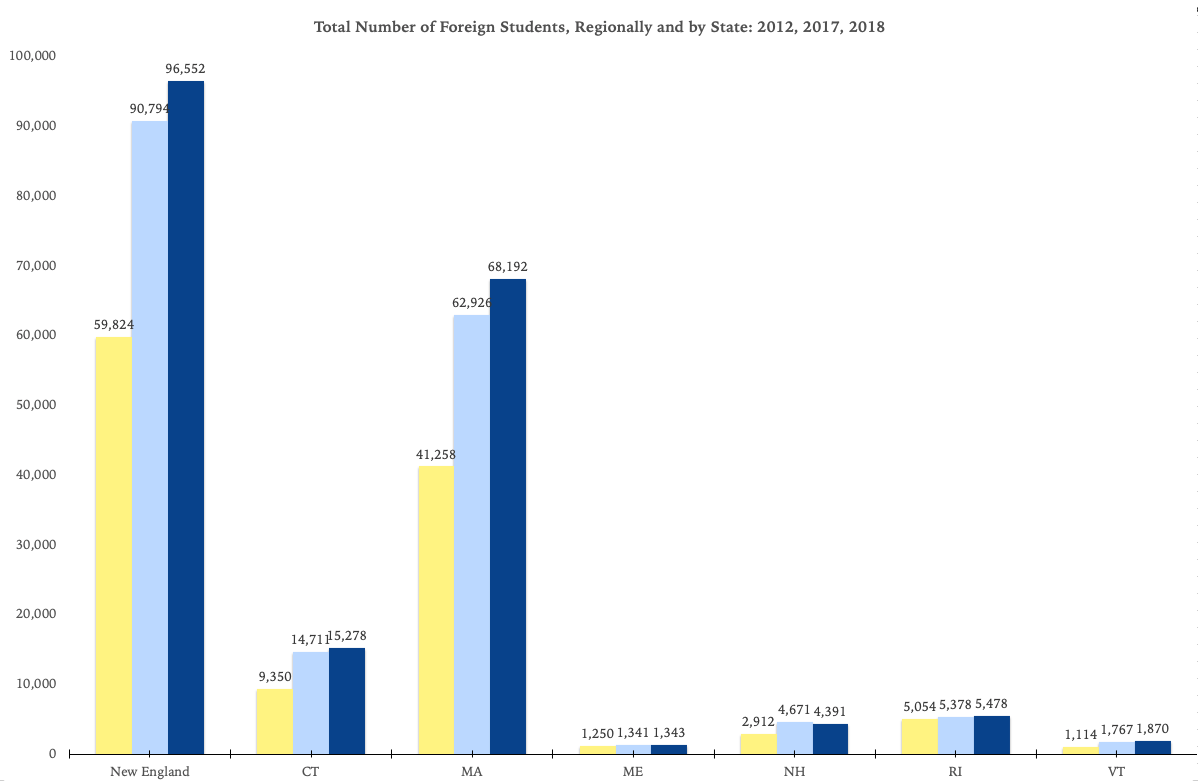 New England faces a concerning dip in its higher education enrollment, due in significant part to declines in the region’s birth and high school graduation rates that are both projected to continue through 2029. Despite these trends, New England’s postsecondary institutions continue to attract a large number of international students to the region, according to the 2018 Open Doors report released by the nonprofit Institute of International Education (IIE) and the U.S. Department of State’s Bureau of Educational and Cultural Affairs (ECA). The report shows:
New England faces a concerning dip in its higher education enrollment, due in significant part to declines in the region’s birth and high school graduation rates that are both projected to continue through 2029. Despite these trends, New England’s postsecondary institutions continue to attract a large number of international students to the region, according to the 2018 Open Doors report released by the nonprofit Institute of International Education (IIE) and the U.S. Department of State’s Bureau of Educational and Cultural Affairs (ECA). The report shows:
• The number of international students in New England has increased every year since 2012 and the region’s growth on this measure now outpaces the nation. In the 2017-18 academic year (AY), the region enrolled 6.3% more international students than the previous academic year. This figure compares to a national increase of only 1.5% during the same period. Both public and private nonprofit institutions in New England saw a 61% rise in the number of foreign students over a five-year period from AY 2012-13 to AY 2017-18, which is comparable to the national growth in the international student population over the same period.
• In 2018, by far the largest share (31%) of international students matriculating at New England colleges and universities originated from China. Nationally, two-thirds of all foreign students come from Asia, and one-third of the total population of international students are from China alone. The other countries rounding out the students’ top five places of origin in the region include India (14.6%), Canada (5.9%), South Korea (4.4%), and Saudi Arabia (3.4%).
• International students represent a big economic injection for New England. In AY 2017-18, international students contributed $39.4 billion to the overall U.S. economy, with $4.2 billion added to the New England economy alone. Between 2012 and 2018, international students contributed a total of $21.3 billion to the New England economy.
• International students have helped forestall a nationwide enrollment crisis. The total higher education population in the U.S. topped out in 2010 at about 21 million students and has been slowly declining since then. The decline in New England is especially acute. This has been countered to some extent by growth of the foreign student population, coupled with a rise in online enrollment, which together comprise almost a quarter of the nation’s students.
• International students help make college more accessible to Americans. Because international students generally pay significantly higher international tuition and fee rates, the recent influx of foreign students has provided a much-needed boost to many college campuses’ bottom lines. The additional revenue generated by the higher fees paid by foreign students helps subsidize the tuition and fees of low-income domestic students who could otherwise not afford to attend college. As the Washington Post recently reported, “contrary to perceptions that foreign students take spots that belong to Americans, at many schools they’re enabling more American students to get a degree.”
What can we expect in 2019?
Despite the economic and cultural value foreign students add to our college campuses and our workforce, New England’s strong international enrollment figures may be in jeopardy in 2019. In particular, over the next year, the region’s colleges and universities may need to prepare for a potential decline in the number of students originating from China. The fragile dependence on Chinese students may soon crack for a number of reasons.
• China’s deepening economic downturn has begun to raise serious concerns in academic admissions offices, as this slowdown threatens to decelerate the influx of Chinese students who have flocked to American campuses to study and bolstered institutions’ bottom lines for the past decade.
• The federal government has begun targeting and encouraging the closure of Confucius Institutes, Chinese government-funded centers for Chinese language and cultural education hosted by over 500 college campuses worldwide, with more than 100 of them in the U.S. These programs have recently come under intense scrutiny by counterintelligence experts, political figures from both sides of the aisle, and those within academe, who argue that the Institutes constitute a broader effort by the Chinese government to conduct espionage, influence American academics, silence free speech and stifle critical analysis of China. Following the passage of a national defense spending law in late 2018 that prohibits the use of appropriated funds for Chinese language instruction at colleges that house a Confucius Institute, several campuses have terminated the program, including the University of Rhode Island (URI), which in December 2018 became the sixth U.S. institution to announce the end of its partnership with the Confucius Institute. A URI representative linked the decision to terminate the program specifically to the potential loss of federal funding.
• In December 2017, the White House released a National Security Strategy plan that stated the U.S. government would consider “restrictions on foreign STEM students from designated countries” as a measure to protect intellectual property. The new screening instructions, which went into effect June 11, 2018, affect the visas of Chinese students pursuing a graduate degree in robotics, aviation or advanced manufacturing, reducing the periods of validity from five years to one year.

Source: NEBHE analysis of data from Open Doors: Report in International Educational Exchange, published annually by IIE and the U.S. Department of State’s Bureau of Educational and Cultural Affairs. www.iie.org/opendoors
Economic impact by state
Connecticut. There were 15,278 international students enrolled at Connecticut institutions in AY 2017-18, which represents an increase of 4% over the previous year and a 63% increase since 2012. In AY 2017-18, Connecticut ranked second in New England and 24th in the U.S. in terms of international student enrollment. Between AY 2012-13 and AY 2017-18, Yale University and the University of Connecticut took the top spots as the universities with the largest share of international students in Connecticut. Foreign students contributed an estimated $584 million to Connecticut’s economy in the past year.
Maine. There were 1,343 international students enrolled in Maine colleges and universities in AY 2017-18, a 0.2% increase from the previous year, and a 7% increase since 2012. Maine has the lowest number of international students in New England, and it ranks 49th in the nation. Between 2012 and 2017, the University of Maine held the top spot for enrolling the greatest share of international students. International students at Maine’s four-year colleges and universities generated a total of $49 million in economic activity for the state in 2017-18.
Massachusetts. There were 68,192 foreign students enrolled in Massachusetts colleges and universities in AY 2017-18, which represents an 8.4% jump over the previous year and a 65% increase over the past five years. In AY 2017-18, Massachusetts ranked first in New England and fourth in the U.S. in terms of international student enrollment. Northeastern University has consistently enrolled the largest share of international students in the Bay State over the past five years. Foreign students contributed an estimated $3 billion to the Massachusetts economy in the past year.
New Hampshire. There were 4,391 international students enrolled in New Hampshire colleges and universities in AY 2017-18, a 6% decrease from the previous year, and a 33% increase over the past five years. New Hampshire ranks 39th in the U.S. in enrolling international students. Every year between 2012 and 2018, Dartmouth College enrolled the largest share of international students in the state. In 2017-18, international students contributed a total of $155 million in activity for the state.
Rhode Island. A total of 5,748 international students enrolled in Rhode Island colleges and universities in AY 2017-18, which represents an increase in enrollment of 2% over the last year, and an increase of 8% since 2012. Rhode Island ranks 33rd in the U.S. in terms of international student enrollment. Between 2013 and 2015, Johnson & Wales University enrolled the largest share of international students in Rhode Island, and in 2012, 2016, and 2017, Brown University took the top spot. Rhode Island’s economy has received a total impact of $256 million from these students in AY 2017-18.
Vermont. A total of 1,870 international students enrolled in Vermont colleges and universities in AY 2017-18, which represents a 6% increase from the previous year, and a 40% increase over the past five years. Vermont has the second lowest enrollment of international students in New England and is fourth from the bottom nationally. Between 2012 and 2017, the University of Vermont enrolled the greatest number of international students. Vermont’s economy received a total of $88 million from this international enrollment in 2017-18.
Stephanie Suarez is a master’s candidate at the Harvard Graduate School of Education and NEBHE policy intern.
Related Posts:
A Trade War We Are Winning: Opportunism and its Consequences in International Enrollments
Celebrating International Education While Closing Minds and Borders?
International Affairs: Survival Kit for Small and Medium-Sized Universities and Colleges
World Ready? Fall 2006 Connection Explores New England’s Place in the Global Student Market
[ssba]
